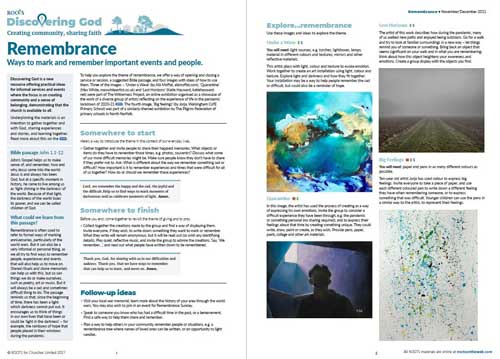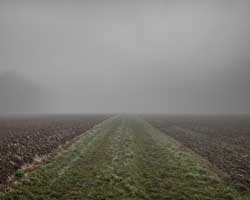Ways to mark and remember important events and people
| |
Thank you for registering for this free Discovering God resource.
(Have you been sent this link by someone else? We'd be grateful if you could please register in your own right to use these resources. There is no charge to you, but it helps us to monitor takeup so that we can plan for the future. Thank you.)
|
|
Discovering God is a new resource offering practical ideas for informal services and events where the focus is on creating community and a sense of belonging, demonstrating that the church is available to all.
Underpinning the materials is an intention to gather together and with God, sharing experiences and stories, and learning together. Find out more.

Click on the image to view a PDF.
Bible passage John 1.1-12
John’s Gospel helps us to make sense of, and remember, how and why Jesus came into the world. Jesus is and always has been God, but at a specific moment in history, he came to live among us as ‘light shining in the darkness’ of the world. Because of that light, the darkness of the world loses its power, and we can be called children of God.
What could we learn from this passage?
Remembrance is often used to refer to formal ways of marking anniversaries, particularly of the world wars. But it can also be a very informal or personal thing, as we all try to find ways to remember people, experiences and events that will also help us to move on. Shared rituals and stone memorials can help us with this, but so can things we do or make ourselves, such as poetry, art or music. But it will always be a sad and sometimes difficult thing to do.
The passage reminds us that, since the beginning of time, there has been a light which darkness cannot put out. It encourages us to think of things in our own lives that have been or could be ‘light in the darkness’ – for example, the rainbows of hope that people placed in their windows during the pandemic.
To help you explore the theme of remembrance, we offer a way of opening and closing a service or session, a suggested Bible passage, and four images with ideas of how to use them. Three of the images – ‘Under a Wave’ (by Abi Moffat, abimoffat.com), ‘Quarantine’ (Max White, maxwhiteartist.co.uk) and ‘Lost Horizons’ (Katie Hayward, katiehayward.net) were part of The Wilderness Project, an online exhibition organised as a showcase of the work of a diverse group of artists reflecting on the experience of life in the pandemic lockdown of 2020-21. The fourth image, ‘Big feelings’ (by Jorja, Walsingham CofE Primary School) was part of a similarly-themed exhibition by The Pilgrim Federation of primary schools in North Norfolk.
Somewhere to start
Here’s a way to introduce the theme in the context of our everyday lives.
Gather together and invite people to share their happiest memories. What objects or items do they have to remember those times, e.g. photos, souvenirs?
Discuss what some of our more difficult memories might be. Make sure people know they don’t have to share if they prefer not to.
Ask: What is different about the way we remember something sad or difficult? How important is it to remember experiences and times that were difficult for all of us together? How do or should we remember these experiences?
Lord, we remember the happy and the sad, the joyful and the difficult.
Help us to find ways to mark moments of darkness
as well as celebrate moments of light. Amen.
Somewhere to finish
Before you end, come together to revisit the theme of giving and to pray.
Collect together the creations made by the group and find a way of displaying them. Invite everyone, if they wish, to write down something they want to mark or remember. What they write will remain anonymous, but it will be read out (so omit any identifying details).
Play quiet, reflective music, and invite the group to admire the creations. Say, ‘We remember…’, and read out what people have written down to be remembered.
Thank you, God, for sharing with us in our difficulties and sadness.
Thank you, that we have ways to remember
that can help us to learn, and move on. Amen.
Follow-up ideas
- Visit your local war memorial to learn more about the history of your area through the world wars. You may also wish to join in an event for Remembrance Sunday.
- Speak to someone you know who has had a difficult time in the past, or a bereavement. Find a safe way to help them share and remember.
- Plan a way to help others in your community remember people or situations, e.g. a remembrance tree where names of loved ones can be written, or an opportunity to light candles.
Explore...remembrance
Use these images and ideas to explore the theme.
Under a Wave E S
You will need: light sources, e.g. torches, lightboxes, lamps; material in different colours and textures; mirrors and other reflective materials.
This artist plays with light, colour and texture to evoke emotion. Work together to create an art installation using light, colour and texture. Explore light and darkness and how they fit together. Your installation may be a way to help people remember the sad or difficult, but could also be a reminder of hope.

Quarantine W E
In this image, the artist has used the process of creating as a way of expressing his own emotions. Invite the group to consider a difficult experience they have been through, e.g. the pandemic or something personal (no sharing required), and to express their feelings about that time by creating something unique. They could write, draw, paint or create, as they wish. Provide pens, paper, paint, collage and other art materials.

Lost Horizons E S
The artist of this work describes how, during the pandemic, many of us walked new paths and enjoyed being outdoors. Go for a walk and try to look at familiar surroundings in a new way – let things remind you of someone or something. Bring back an object that seems significant on your walk and in what you are remembering; think about how this object heightens your awareness and emotions. Create a group display with the objects you find.

Big Feelings W E S
You will need: paper and pens in as many different colours as possible.
Ten-year old artist Jorja has used colour to express big feelings. Invite everyone to take a piece of paper, and use each different coloured pen to write down a different feeling they have when remembering someone, or to express something that was difficult. Younger children can use the pens in a similar way to the artist, to represent their feelings.
